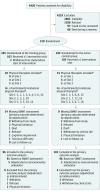Effect of a Multicomponent Home-Based Physical Therapy Intervention on Ambulation After Hip Fracture in Older Adults: The CAP Randomized Clinical Trial
- PMID: 31503309
- PMCID: PMC6737521
- DOI: 10.1001/jama.2019.12964
Effect of a Multicomponent Home-Based Physical Therapy Intervention on Ambulation After Hip Fracture in Older Adults: The CAP Randomized Clinical Trial
Abstract
Importance: Disability persists after hip fracture in older persons. Current rehabilitation may not be sufficient to restore ability to walk in the community.
Objective: To compare a multicomponent home-based physical therapy intervention (training) with an active control on ability to walk in the community.
Design, setting, and participants: Parallel, 2-group randomized clinical trial conducted at 3 US clinical centers (Arcadia University, University of Connecticut Health Center, and University of Maryland, Baltimore). Randomization began on September 16, 2013, and ended on June 20, 2017; follow-up ended on October 17, 2017. Patients aged 60 years and older were enrolled after nonpathologic, minimal trauma hip fracture, if they were living in the community and walking without human assistance before the fracture, were assessed within 26 weeks of hospitalization, and were not able to walk during daily activities at the time of enrollment. A total of 210 participants were randomized and reassessed 16 and 40 weeks later.
Interventions: The training intervention (active treatment) (n = 105) included aerobic, strength, balance, and functional training. The active control group (n = 105) received transcutaneous electrical nerve stimulation and active range-of-motion exercises. Both groups received 2 to 3 home visits from a physical therapist weekly for 16 weeks; nutritional counseling; and daily vitamin D (2000 IU), calcium (600 mg), and multivitamins.
Main outcomes and measures: The primary outcome (community ambulation) was defined as walking 300 m or more in 6 minutes at 16 weeks after randomization. The study was designed to test a 1-sided hypothesis of superiority of training compared with active control.
Results: Among 210 randomized participants (mean age, 80.8 years; 161 women [76.7%]), 197 (93.8%) completed the trial (187 [89.0%] by completing the 6-minute walk test at 16 weeks and 10 [4.8%] by adjudication of the primary outcome). Among these, 22 of 96 training participants (22.9%) and 18 of 101 active control participants (17.8%) (difference, 5.1% [1-sided 97.5% CI, -∞ to 16.3%]; 1-sided P = .19) became community ambulators. Seventeen training participants (16.2%) and 15 control participants (14.3%) had 1 or more reportable adverse events during the intervention period. The most common reportable adverse events reported were falls (training: 6 [5.7%], control: 4 [3.8%]), femur/hip fracture (2 in each group), pneumonia (training: 2, control: 0), urinary tract infection (training: 2, control: 0), dehydration (training: 0, control: 2), and dyspnea (training: 0, control: 2).
Conclusions and relevance: Among older adults with a hip fracture, a multicomponent home-based physical therapy intervention compared with an active control that included transcutaneous electrical nerve stimulation and active range-of-motion exercises did not result in a statistically significant improvement in the ability to walk 300 m or more in 6 minutes after 16 weeks.
Trial registration: ClinicalTrials.gov Identifier: NCT01783704.
Conflict of interest statement
Figures

Comment in
-
Home-Based Physical Therapy for Older Adults After Hip Fracture.JAMA. 2020 Jan 28;323(4):378. doi: 10.1001/jama.2019.19266. JAMA. 2020. PMID: 31990305 No abstract available.
-
Home-Based Physical Therapy for Older Adults After Hip Fracture.JAMA. 2020 Jan 28;323(4):378-379. doi: 10.1001/jama.2019.19269. JAMA. 2020. PMID: 31990306 No abstract available.
References
Publication types
MeSH terms
Associated data
Grants and funding
LinkOut - more resources
Full Text Sources
Medical
Miscellaneous

